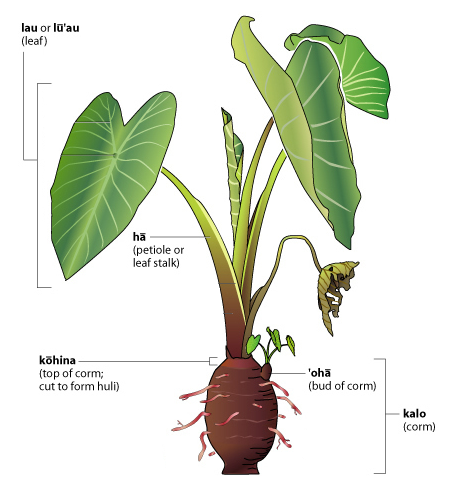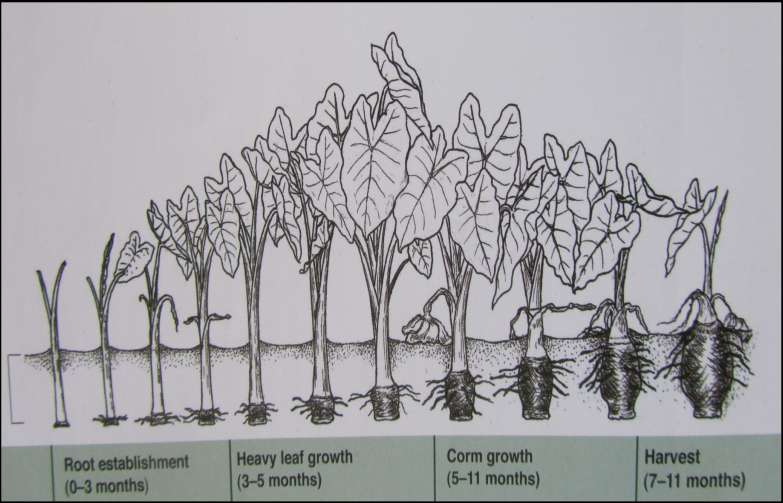Ke Kalo - The Taro Plant
- useduforce

- May 14, 2022
- 4 min read
Updated: Nov 7, 2022
This blog post is an overview of what taro (kalo) is, specifically in Hawaiʻi,
and will cover the basics of the plants history and usage -
with Hawaiian vocab included!

Taro is a root vegetable plant that’s enjoyed all over the world, largely grown in Southeast Asia, parts of Africa, and Oceania/Polynesia. In ancient Hawaiʻi, taro, known as kalo in Hawaiian, was an important staple food that provided sustenance for most of the people, but also served a number of other purposes. Kalo was brought over as a “canoe plant” (among other items) when the Polynesians first arrived on the islands, so the history and continued propagation of certain varieties of the kalo plant is as old as the Hawaiian people!

Map of taro output worldwide

Map of Austronesian migration, route to Hawaiʻi highlighted
Transportation of "canoe plants"
Colocasia esculenta is the scientific name for this taro, but there are a multitude of varieties (or “cultivars”) that appeared from many years of horticulture. These types produced all sorts of shapes, sizes, colors, and tastes of the plant, and therefore delivered a wide array of purposes! For example, at one point, the Lehua and Piʻi aliʻi varieties, with their characteristic red hues, were only to be eaten by the royalty (or aliʻi). Others would be utilized as medicines, sacrifices, or even dyes!
Let’s take a peek at what the full plant actually consists of:

Diagram of a matured taro plant
(From the Bishop Museum, edited for simplicity)
The kalo plant consists of a leaf (often called “elephant ears” due to its shape!) called lau or lūʻau (recognize that last one?), a stem (or “petiole”) called hā, and the corm. The word kalo can be used to refer to the entire plant, or just the corm, so this term can be confusing when speaking generally. In English, other synonyms to corm include tuber and root, and is frequently likened to the potato or other starchy, root vegetables. As long as they’re cooked thoroughly, all parts of this plant can be eaten!
To propagate, or produce more of, kalo, you need to make a huli. To do this, the mahi ʻai (or “farmer”) cuts off the leaf and the corm around the point of the kōhina, located just above the corm. That’s all that’s needed to make the huli! This acts as a seed.

Huli - taro plant with leaves and corm cut off to act as a seed for replanting
(From this video)
There are two different sites to plant this huli: in wetland areas (called loʻi) or in dryland/upland areas (called māla). This means that the huli can be lightly submerged in flooded muddy waters or under mulchy soil. Each cultivation style has its own advantages and disadvantages on growth and maturation.

Huli planted in a loʻi, or wetland setting
(From this video)

Huli planted in a māla, or dryland setting
(From this video)
Depending on the variety of kalo, it takes about 8-12 months to be fully matured for harvest! In the meantime, several sprouts called ʻohā stem from the main corm. The main plant is affectionately known as the makua (meaning “parent” or “mother”) and the ʻohā as keiki (or "children")!

Growth chart of taro
(From this UH PowerPoint)

Kalo plant - makua highlighted, keiki (ʻohā - smaller taro growing off of the makua) surrounding
(From this video, edited for emphasis)
When it’s harvested, it’s time to eat! You might recognize the most famous dish made from kalo: poi! Taro is cut, steamed, peeled, then pounded into this acidic paste. Eaten with fingers, a calabash bowl of this stuff gathers family around the table and only invites positive company and conversation. Poi was so common in ancient Hawaii, it was commonly known simply and generally as ʻai (“food”). Some kalo varieties are particularly favorable for preparing poi, such as Lehua, Moi, Piko, and Kāī. Others are preferred as table taro, such as Mana, Lauloa, and Leo. There are even taro plants enjoyed for their desirable leaves for the famous lūʻaus, such as Aweu, Apuwai, and Haokea!

Pounding kalo into poi

Bowl of poi, eaten with two fingers
(From this video)

Table taro - corm peeled and chopped, ready to be cooked and mashed
(From this video)
Another tasty treat is the dessert known as kūlolo! Similar to the ingredients of haupia, this is a pudding the combines grated kalo, coconut milk, and sugar before it is steamed.

Kūlolo pudding dessert - includes grated kalo before steaming
(From this video)
If you look for specific taro cultivars, they can be difficult to find. Since foreign contact in 1778, the caring of kalo has decreased to frightening numbers (some varieties have even gone extinct) due to replacing such fields with other carb-rich plant sources, such as rice, by immigrant farmers and new opportunities appealing to the mahi ʻai, among other reasons. There are current efforts by the University of Hawaii, in collaboration with modern kalo farms across the islands, to raise and propagate all known Hawaiian kalo cultivars in order to save taro from its endangered status.
This is everything you need to know about Hawaiian taro plant! This root stems so far back in Hawaiʻi's history that there is a highly regarded ancient myth about its origin [coming soon].
SOURCES:
Bishop Museum:
[1] "What is Kalo?" - http://hbs.bishopmuseum.org/botany/taro/key/HawaiianKalo/Media/Html/whatistaro.html
[2] "A Brief History of Taro in Hawai‘i" - http://hbs.bishopmuseum.org/botany/taro/key/HawaiianKalo/Media/Html/history.html
[3]"The Colors of Poi" - http://hbs.bishopmuseum.org/botany/taro/key/HawaiianKalo/Media/Html/characters/poi.html
[4] "Glossary of Kalo Terms" - http://hbs.bishopmuseum.org/botany/taro/key/HawaiianKalo/Media/Html/glossary.html
[5] "Observations on varieties and culture of taro" - https://hawaiialive.org/observations-on-varieties-and-culture-of-taro/
University of Hawaii, CTAHR (Agricultural Department):
[6] "Taro Varieties in Hawaii" - https://www.ctahr.hawaii.edu/Site/Taro.aspx
[7] PPT "Upland Taro" - https://www.kohalacenter.org/seedbasicsworkshop/pdf/presentationshawaii/GlennTevesGrowingTaro.pdf
[8] "Taro: Postharvest Quality-Maintenance Guidelines" - https://www.ctahr.hawaii.edu/oc/freepubs/pdf/VC-5.pdf
[9] "Hawaiian Kalo, Past and Future" - https://www.ctahr.hawaii.edu/oc/freepubs/pdf/SA-1.pdf
[10] "Kalo [Hawaiian Taro, Colocasia esculenta (L.) Schott] Varieties: An assessment of nomenclatural synonymy and biodiversity" - https://www.researchgate.net/publication/265294634_Kalo_Hawaiian_Taro_Colocasia_esculenta_L_Schott_Varieties_An_assessment_of_nomenclatural_synonymy_and_biodiversity
Encyclopedic:
[11] Wikipedia, "Taro" - https://en.wikipedia.org/wiki/Taro
[12] World History Encyclopedia, "Polynesian Navigation & Settlement of the Pacific" - https://www.worldhistory.org/article/1586/polynesian-navigation--settlement-of-the-pacific/
[13] Britannica - https://www.britannica.com/topic/poi-food
Newspaper:
[13] Papakilo, Ka Hoku o Hawaii, "Papa Inoa o Na Kalo Hawaii" (1918) - https://www.papakilodatabase.com/pdnupepa/?a=d&d=KHHA19180418-01.2.19&e=-------en-20--1--txt-txIN%7ctxNU%7ctxTR--------
Videos referenced in images:
[14] "How To Propagate Kalo (Taro) Dryland Style," Ka Lepo Pōpolo - https://www.youtube.com/watch?v=OJ43OaCcA-M&ab_channel=KaLepoP%C5%8Dpolo
[15] "Waipi'o Valley Poi," Big Island Television, Hawaii - https://www.youtube.com/watch?v=EAfGM55KuLw&ab_channel=BigIslandTelevision%2CHawaii
[16] "Growing Kalo to Perpetuate Hāloa w/ Bobby Pahia," Robyn Pfahl - https://www.youtube.com/watch?v=aJS5b-qH3o4&t=651s&ab_channel=RobynPfahl
[17] "Rainfarm Hawaii Mashed Taro," Seema Hapi - https://www.youtube.com/watch?v=WCWC1eE2-aw&ab_channel=SeemaHapi
[18] "How to Make Hawaiian Dessert - Kulolo (Taro Pudding)," Ono Hawaiian Recipes - https://www.youtube.com/watch?v=ASKY3g373N0&t=3s&ab_channel=OnoHawaiianRecipes
Comments